Aulopiformes are the only order belonging to the Cyclosquamata superorder.
The found remains suggest that Cyclosquamata appeared on the planet in the Late Cretaceous Period, which began more than a hundred million years ago, when a lot of dinosaurs occurred. Some modern representatives of Aulopiformes support their ancient origin both externally and with their scientific names. For example, the largest fish of the order of the Alepisauridae family is long snouted lancetfish (Alepisaurus ferox), which can be more than two meters long and weigh more than 9 kilograms. It inhabits the tropical and subtropical waters of all oceans; it doesn’t enter the Adriatic Sea.

(Long snouted lancetfish. Photo by © DireLobo. whatsthatfish.com)
Aulopiformes have a peculiar gill arch structure, a large mouth. They don’t have a swim bladder. They are hermaphrodites as well.
At the early development stage, some species are so different from adult individuals that some of them were considered different fish until recently.
Aulopiformes are inhabitants of warm waters, and waters of middle latitudes of all oceans. The order comprises 17 existing families, about 45 genera and more than 230 fish species.
Atlantic lizardfish (Synodus saurus), which is called “lizardfish” or simply “lizard” by fishermen, is one of the most famous representatives of the order.
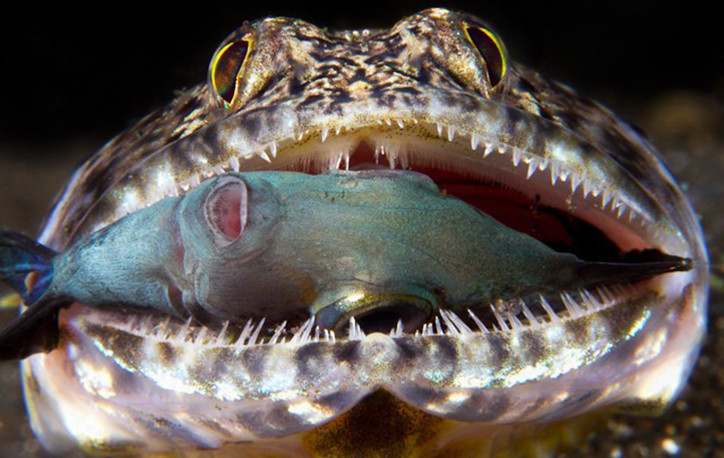
(Atlantic lizardfish. “A Damsel in Distress”. Photo by © Daniel Stassen. thescuttlefish.com)
10 following representatives of 3 suborders and 6 families occur in the Adriatic: the Alepisauroidei suborder with the Evermannelidae family and the Paralepididae family, the Chlorophthalmoidei suborder with the Chlorophthalmidae family and the Ipnopidae family, and the Synodontoidei suborder with the Aulopidae family and the Synodontidae family.
Balbo sabretooth (Evermannella balbo).

(Balbo sabretooth. Photo by © Robin McPhee & Mark McGrouther / NORFANZ Founding Parties. fishesofaustralia.net.au)
It is a bathypelagic species. It inhabits the depths of 100-1,000 meters, usually 400-1,000 meters. The maximum recorded length is 16.9 cm. It feeds on fish. It is the inhabitant of the southern part of the Adriatic Sea.
Spotted barracudina (Arctozenus risso).

(Spotted barracudina. Photo by © Trevor Meyer. fishbase.org)
It is a bathypelagic species. It inhabits the depths of up to 2,200 meters, usually 200-1,000 meters. The maximum recorded length is 30 cm; specimens up to 25 cm are more common. It feeds on fish and shrimps. It is the inhabitant of the southern part of the Adriatic Sea.
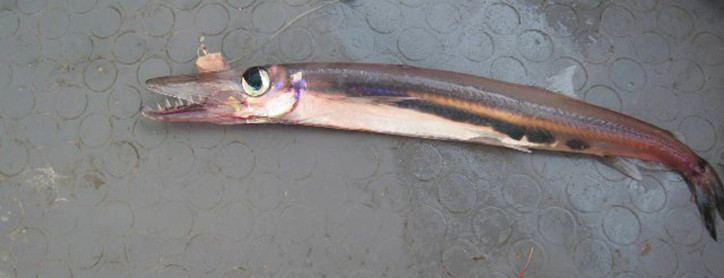
(Lestidiops sphyrenoides. Photo by © Elias Kyriakakis. fishbase.org)
It is a bathypelagic species. It inhabits the depths of 50-600 meters. The maximum recorded length is 27 cm. It feeds on fish, crustaceans and planktonic organisms. This fish occur in the southern part of the Adriatic Sea. It is a rare species.
Sharpchin barracudina (Paralepis coregonoides).

(Sharpchin barracudina. Photo © trawlerphotos.co.uk)
It is a bathypelagic species. It inhabits the depths of 50-1,032 meters, usually 200-600 meters. The maximum recorded length is 50 cm. It feeds on fish, crustaceans and planktonic organisms. It occurs occasionally in the southern part of the Adriatic Sea. It is a rare species.

(Paralepis speciosa. Picture © colapisci.it)
It inhabits the depths of up to 1,000 meters. It is about 12 cm long. It feeds on fish, crustaceans and planktonic organisms. It is the endemic of the Mediterranean Sea, found in the southern part of the Adriatic. It is a rare poorly studied species.
Mediterranean spiderfish (Bathypterois dubius).

(Mediterranean spiderfish. Photo © IEO. digitalarchives.tw)
It is a seep sea bottom fish. It inhabits the depths of 260-2,800 meters. The maximum recorded length is 20.5 cm. It feeds on crustaceans and zooplankton. In the Adriatic Sea, It is occasionally found in the southern part of the Adriatic Sea.
Shortnose greeneye (Chlorophthalmus agassizi).
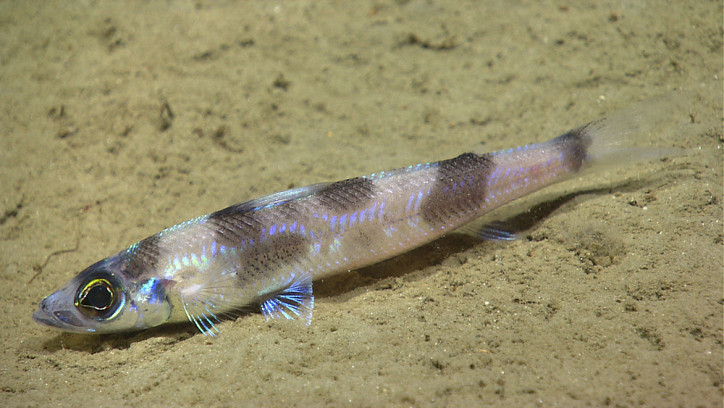
(Shortnose greeneye. Photo © NOAA Photo Library. flickr.com/photos/noaaphotolib)
It inhabits the depths of 50-1,000 meters. It keeps to the oozy or argillaceous bottom. It often forms schools. The maximum recorded length is 40 cm, specimens about 20 cm long are more common. It feeds on bottom invertebrates. It is a rare permanent inhabitant of the Adriatic Sea.
Royal flagfin (Aulopus filamentosus).
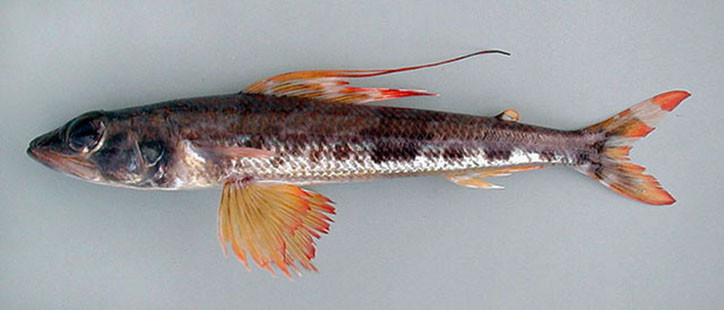
(Royal flagfin. Photo by © Pedro Niny Duarte(c)ImagDOP. fishbase.org)
It is a bottom fish. It inhabits the depths of 50-1,000 meters, usually 100-200 meters. The maximum recorded length is 44 centimeters, specimens up to 30 centimeters long are more common. It feeds on fish and cephalopods. It is a rare permanent inhabitant of the Adriatic Sea. It is more often found in the southern part of the sea.
Brushtooth lizardfish (Saurida undosquamis).

(Brushtooth lizardfish. Photo by © Baki Yokes. elreedy1.blogspot.com)
It inhabits the depths of 1-350 meters. It keeps to the sandy and oozy bottom. The maximum recorded length is 50 cm; specimens up to 30 cm long are more common. It feeds on fish, crustaceans and other invertebrates. It first occurred in the Pacific Ocean near the coast of Malaysia and Indonesia. It entered the Mediterranean Sea through the Suez Canal. It is occasionally found in the Adriatic near the Ionian Sea.
Atlantic lizardfish (Synodus saurus).
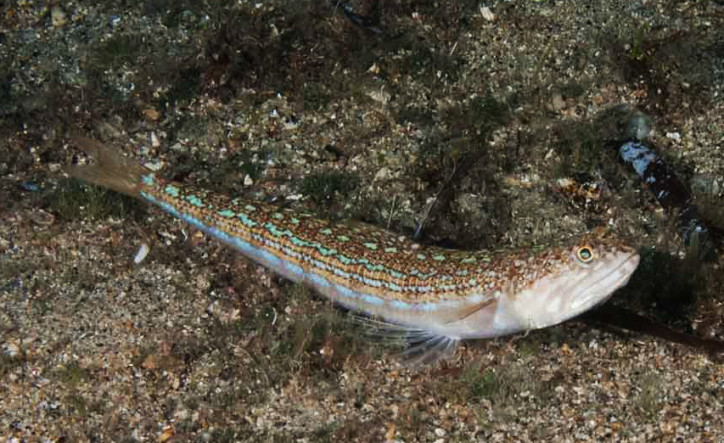
(Atlantic lizardfish. Photo © biologiamarina.org)
It inhabits the depths of 400 meters, usually up to 20 meters. It keeps to the sandy or sandy-rocky bottom. The maximum recorded length is 40 cm, specimens up to 20 cm long are more common. It feeds on fish, as well as other animals. It is a permanent inhabitant of the coastal waters of the Adriatic Sea.